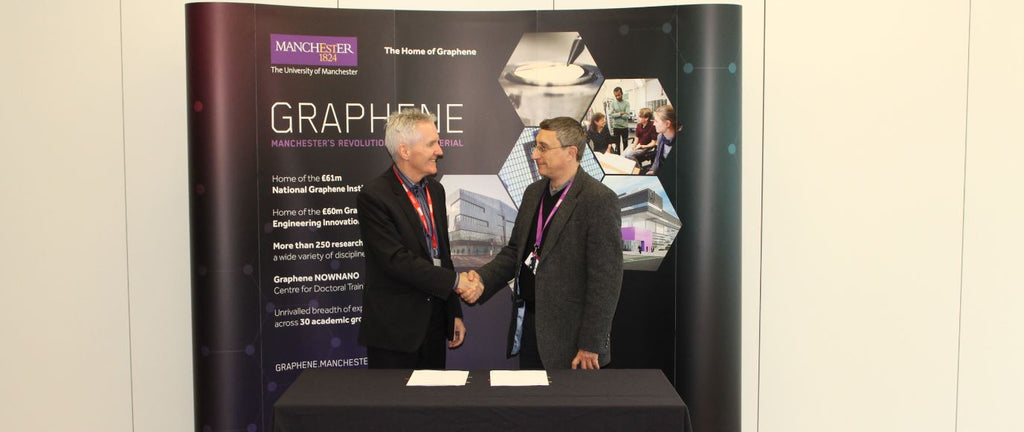News — william blythe
Graphene Oxide Enhanced Organic Solvent Nanofiltration
Organic solvent nanofiltration (OSN) is an important technique used by the pharmaceutical and petrochemical industries to selectively separate molecules in processes such as solvent exchange, catalyst recovery and purification.
These processes are highly resource intensive because of the high pressures and large amounts of solvent required, so researchers endeavour to find new materials that can increase permeance through the filter membrane whilst retaining high selectivity. 2D materials such as graphene and graphene oxide are attractive high performance additive solutions to this problem.
In 2018, researchers at the University of Manchester investigated the functionalisation of poly(benzimidazole) OSN membranes with graphene oxide supplied by William Blythe. Graphene oxide excels in this application through its versatility during the deposition process in being both water and solvent soluble and chemically reactive via the oxygenated functional groups on the surface of the sheets. These features make it easy to handle and provide tuneable functionality.
Blanford and colleagues identified that the hydroxyl groups on graphene oxide can be covalently cross-linked to the polymeric membrane, and this functionality improves the separation performance.
The functionalisation process consisted of three steps: i) hydroxylating the poly(benzimidazole) via N-benzylation; ii) cross linking the hydroxylated poly(benzimidazole) with toluene diisocyanate; and iii) anchoring the graphene oxide sheets via covalently bonding to toluene diisocyanate and cross-linking with other graphene oxide sheets.
The performance of the membranes was evaluated in cross-flow filtration. The researchers found that the membrane containing graphene oxide achieved an acetone permeance that was 18 times greater than a commercial OSN membrane and 5 times greater than the control poly(benzimidazole) membrane. Other solvents were also trialled which exhibited similarly high permeance results, despite the concentration of graphene oxide in the membrane being very low (1-2%).
This is an exemplary study for how high-quality graphene oxide from William Blythe Ltd can be used at commercially viable scales to achieve significant performance enhancements. To learn more about graphene oxide functionalisation for optimisation in your application, please get in touch with our business development manager Mike Butler and visit our website.
ACS Appl. Mater. Interfaces, 2018, 10, 18, pp.16140-16147.
William Blythe Launches New Collaboration with the NGI
William Blythe recently announced the launch of a new collaborative project with the National Graphene Institute (NGI) at the University of Manchester. This project will investigate novel anode materials for use in energy storage, specifically targeting increased capacity to extend the range of current electric vehicles. Andrew Hurst, Managing Director at William Blythe commented: "We are excited to be undertaking this important development project with Professor Dryfe and his team at the NGI. A combination of William Blythe’s capability in inorganic chemistry and the Institute's global pre-eminence in graphene offers real potential to solve one of the significant problems limiting the adoption of electric vehicles."
Throughout this two year project, William Blythe will supply GOgraphene graphene oxide products to researchers throughout the NGI. The arrangement established will allow extended access to William Blythe’s material which is already in use in a number of projects at the Institute.
Professor Vladimir Falko, Director of the National Graphene Institute said: “The researchers based in the NGI rely on highly consistent and top-quality graphene materials to progress our research and aid in the development of commercial applications. This new partnership with William Blythe allows the University’s graphene scientists greater access to necessary materials with which to work with, in tandem with a project exploring the possibilities of 2D materials and new battery technologies.”
The Forefront of Graphene Commercialisation: An Update
Last week, the William Blythe team showcased their work with graphene oxide at the most recent CIR Strategy conference in Cambridge. The event featured esteemed delegates with expertise in a variety of sectors including the field of advanced materials: a promising and ever-expanding area of scientific development. This conference acted as a platform to discuss breakthrough technologies in the academic and commercial world of nanomaterials, and here is just a snippet of what we learnt.
The ISO standardisation for a variety of 2D materials now states that graphene materials must have fewer than 10 layers, which can be measured using the AFM or Raman/SEM coupled analysis techniques used for the GOgraphene range. It was apparent that the production of ‘high quality’ graphene materials is required for commercialisation, indicating high purity, consistency from batch to batch, affordability and most importantly, performance.
The scope for the applications of graphene materials ranges from polymer composites to biomedical applications. Energy storage was a recurring theme throughout the sessions, with the inclusion of reduced graphene oxide into battery and fuel cell technologies allowing for an advanced device with higher performances. Graphene materials even have the promising uses in aerospace applications. With its exceptional strength at very low weight loadings, the incorporation of graphene materials can drastically reduce vehicle mass. This leads to savings on fuel, in conjunction with electronic and thermal conductivity properties obtained with a reduced graphene oxide/graphene material.
The 15th HVM and 4th GNM conference was a superbly organised and informative event, and the William Blythe team look forward to attending more distinguished events in the future. If you are currently working in any sectors noted in this article and would like to know how graphene oxide can improve your technology, please do get in touch.
William Blythe Attends the 4th Graphene New Materials and 15th HVM Conference
On the 2nd and 3rd November, the city of Cambridge will stage a unique crossover of the 4th Graphene and New Materials and the 15th High Value Manufacturing (HVM) conferences, hosted by the Cambridge Investment Research (CIR) team. This prestigious event will showcase the most recent advances for industrial automation in HVM and the use of graphene materials in applications such as aerospace & defence, electronics, sensors, energy storage, printing and biomedicine, delivered by senior executives and experts in each respective field.
William Blythe will be among those presenting in the ‘Enabling Technology and Industry’ Session on the first day of the conference. This presentation will briefly explore William Blythe as a company, their development and scale up work on graphene oxide which has been achieved in recent years, before concluding with the company’s ability to tune graphene oxide to suit a variety of applications.
The inclusion of graphene materials throughout this conference evidences the materials' flexibility in a variety of sectors, and the drive to commercialise these 2D materials. William Blythe aims to work with its customers in optimising graphene oxide to each specific application and therefore hopes to connect with researchers interested in graphene oxide at this event. If you would like to learn more about our aims, or to arrange a meeting with a member of the William Blythe team at this event, please get in touch.




